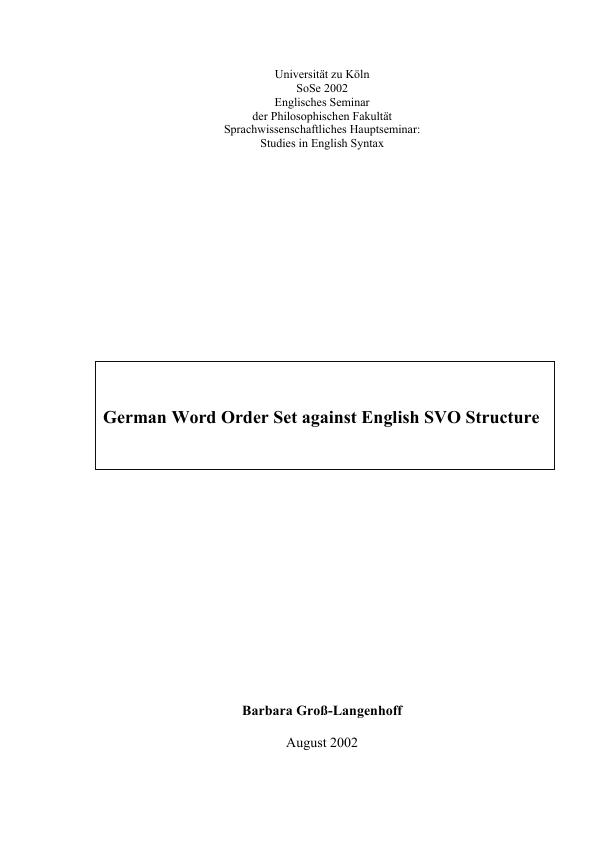Introduction:
In comparison to English, the German language does not seem to have a specific word order. The distinction between grammatical functions like subjects or objects is mainly due to case-inflection and prepositions. For that reason, word order in German sentences can vary to some extent without a fundamental change in meaning.
In the following analysis of German syntax, we are going to consider a possibility of finding the basic German word order. On the basis of the Government and Binding Theory, a widely accepted approach to syntactic analysis, we are going to argue that the structure of a subordinate clause underlies every German sentence. In doing so, we will find that the position of the verb will play a pivotal role.
With the help of a clear characterisation, it becomes easier to understand German syntax and to contrast it with other languages such as English. Although the two languages are closely related in historical terms, German sentence structure differs from English SVO (subject-verb-object) word order, which we will examine in chapter III. But before we can embark on the study of English and German syntax, we need to introduce a considerable amount of terminology and syntactic principles, which will form the necessary set of rules in our subsequent analysis.
Kurzer Überblick auf Deutsch:
Diese Arbeit sucht auf der Grundlage der Government and Binding Theory nach der Basisstruktur eines jeden deutschen Satzes. Während in der englischen Sprache die Subjekt-Verb-Objekt-Struktur vorliegt, und man mit Blick auf deutsche Hauptsätze Gleiches im Deutschen vermuten könnte, so bringt diese Arbeit eine Vielzahl von Argumenten, die eine Subjekt-Objekt-Verb-Struktur in der deutschen Sprache nahe legen. Ungläubig? Eine kurze Übersetzung von „to sing a song“ oder „to watch a movie“ verdeutlicht die unterschiedliche Wortstellung in den beiden Sprachen bereits ganz gut.
Inhaltsverzeichnis (Table of Contents)
- Introduction
- Typical interrelations between constituents
- Dominance
- (Strict) c-command and m-command
- Government
- Movement transformations
- Head-to-head movement
- Wh-movement
- Typical interrelations between constituents
- Problems in the analysis of the position of the verb in German sentences
- The verb-second constraint
- Sentence formation by movement transformations
- Arguments for leftward verb-movement in main clauses
- Parametric variation between English and German
- The head parameter
- Verb-movement in English and German
- Conclusion
Zielsetzung und Themenschwerpunkte (Objectives and Key Themes)
This seminar paper aims to investigate the structural differences between German and English word order, particularly focusing on the position of the verb. By analyzing the syntactic structures of both languages, the paper explores the role of movement transformations and the verb-second constraint in German. It aims to provide a clear explanation of German syntax and its contrast with the English SVO structure.
- The influence of movement transformations on sentence structure
- The verb-second constraint in German and its implications for word order
- Parametric variation between English and German syntax
- The role of the head parameter in determining word order
- The difference between English SVO structure and German word order
Zusammenfassung der Kapitel (Chapter Summaries)
The introduction defines key concepts such as dominance, c-command, and government within the X-bar scheme, forming a framework for the subsequent analysis. It then introduces the concept of movement transformations, including head-to-head movement, as a means to explain sentence construction.
The second chapter delves into the analysis of verb position in German sentences, focusing on the verb-second constraint and its role in sentence formation. The chapter explores arguments for leftward verb-movement in main clauses, highlighting the complexity of German word order.
The third chapter examines the parametric variation between English and German, focusing on the head parameter and its influence on verb-movement. It compares the English SVO structure to the more flexible word order of German, emphasizing the key differences between these two closely related languages.
Schlüsselwörter (Keywords)
This study delves into the intricate aspects of German syntax, particularly exploring the role of movement transformations, the verb-second constraint, and parametric variation with English. Key concepts include dominance, c-command, government, head-to-head movement, and the head parameter. The analysis contrasts the German word order with the English SVO structure, offering insights into the structural differences between these closely related languages.
- Quote paper
- Barbara Groß-Langenhoff (Author), 2002, German Word Order Set Against English SVO Structure, Munich, GRIN Verlag, https://www.grin.com/document/30493



